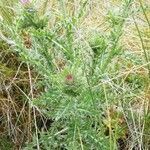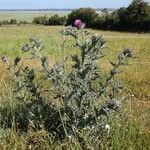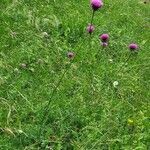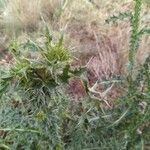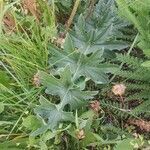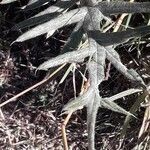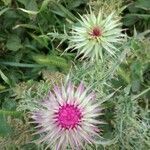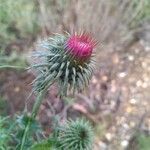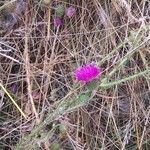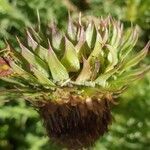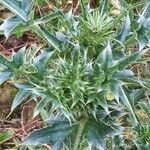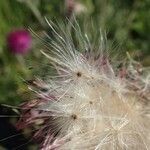Herbs 30-100 cm tall, biennial or perennial. Stems grayish white, usually branched, sparsely cobwebby and hirsute below, densely cobwebby-felted above; wings continuous, unequally toothed; teeth triangular, margin and apex with spines. Leaves green, concolorous, hirsute along veins or sparsely cobwebby. Lower and middle cauline leaves sessile, ovate to lanceolate, (5-)10-40 × (1.5-)3-10 cm, pinnatifid or pinnatipartite; segments 5-7 pairs, obliquely triangular to triangular-ovate, margin spinulose, apex with a 4-6 mm spine. Upper cauline leaves similar but gradually smaller upward, pinnately lobed or entire. Capitula 4-6, solitary at end of stem and branches, ± nodding. Involucre ± broadly campanulate, 4-7 cm in diam. Phyllaries slightly constricted at or beyond middle then expanded into a lanceolate, spiny-tipped, and patent to recurved distal portion; outer phyllaries 14-15 × 4-5 mm; middle and inner phyllaries 1.5-2 × ca. 0.5 cm; innermost phyllaries broadly linear to linear-lanceolate, 2-2.2 × 0.2-0.3 cm, not constricted. Corolla purplish red, ca. 2.5 cm, tube ca. 1.3 cm. Achene grayish yellow with pale brown striae, ca. 3.5 mm. Pappus bristles white, unequal, to 2 cm. Fl. and fr. Jun-Sep. 2n = 16, 40.
Annuals or biennials, 40–200+ cm. Stems glabrous to tomentose; teeth of wings to 10 mm, wing spines 2–10 mm. Leaves: basal tapering to winged petioles, blades 10–40 cm, margins 1–2×-pinnately lobed; cauline sessile, shorter, margins less divided, glabrous or ± hairy. Heads borne singly or in corymbiform arrays, sometimes a few axillary, at least terminal head usually conspicuously pedunculate, often nodding, 20–40 mm. Peduncles 2–30 cm, unwinged distally or throughout, finely tomentose. Involucres hemispheric, 20–60 mm × 20–70 mm. Phyllaries lanceolate to ovate, outer and middle with appressed bases 2–4 mm wide and spreading to reflexed, appendages 2–7 mm wide, proximally glabrous or ± tomentose, distally glabrous to minutely scabridulous. spine tips 1–4 mm, inner phyllaries with unarmed, straight or twisted tips. Corollas purple, 15–28 mm, lobes 2.5–3 times longer than throat. Cypselae golden to brown, 4–5 mm; pappus bristles 13–25 mm. 2n = 16.
Herb to 1.5 m high. Stem sparsely to moderately pubescent; wings 3–10 mm wide. Leaves green, with multicellular hairs mainly along midrib and on major veins; glands absent; marginal spines 2–6 mm long, white to brownish. Capitula solitary, terminal on 10–40 cm long side-branches, nodding at maturity; involucre depressed-globose, 20–45 mm wide excluding patent bracts, persistent; median involucral bracts patent or recurved, narrowly deltate, 22–29 mm long, 2.5–3.5 mm wide at widest point, entire, sparsely arachnoid dorsally. Corolla tube 13–17 mm long; lobes 6–8 mm long. Anthers 6–7 mm long. Achenes ellipsoid, 3.3–3.8 mm long, brown, with darker longitudinal streaks. Pappus bristles 130–169, 15–20 mm long.
Biennial, 3-20 dm; lvs glabrous, or long-villous chiefly along the main veins beneath, deeply lobed, to 25 × 10 cm; heads mostly solitary and nodding at the ends of the branches, usually large, the disk (1.5-)4-8 cm wide (pressed); peduncles naked for some distance below the head; middle and outer invol bracts conspicuously broad (2-8 mm), with long, flat, spreading or reflexed, spine-pointed tip; inner bracts narrower and softer; 2n=16. Roadsides and waste places; native of Europe, now widely established in the U.S. and adj. Can., commoner westward. June-Oct. (C. thoermeri) Hybridizes with no. 2 [Carduus acanthoides L.], the hybrids partly fertile.
It is a thistle. An erect herb which keeps growing from year to year. It grows 2 m high. The leaves are grey-green. They have deep lobes and are spiny. The leaves continue down the stems as wings. The flowers are large and red or purple and drooping. They are 5-6.5 cm across. The flowers are at the ends of branches.
